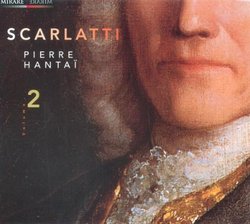| All Artists: Domenico Scarlatti, Pierre Hantaï Title: Scarlatti 2 - Pierre Hantaļ Members Wishing: 0 Total Copies: 0 Label: MIRARE Original Release Date: 1/1/2005 Re-Release Date: 8/9/2005 Album Type: Import Genre: Classical Styles: Chamber Music, Forms & Genres, Sonatas, Historical Periods, Baroque (c.1600-1750), Classical (c.1770-1830) Number of Discs: 2 SwapaCD Credits: 2 UPC: 3760020170202 |
Search - Domenico Scarlatti, Pierre Hantaï :: Scarlatti 2 - Pierre Hantaļ
 | Domenico Scarlatti, Pierre Hantaï Scarlatti 2 - Pierre Hantaļ Genre: Classical
|
Larger Image |
CD Details |
CD ReviewsMore Laser Guided Scarlatti G. Winford | Whidbey Island, WA | 08/20/2005 (5 out of 5 stars) "Pierre Hantai's first Scarlatti disc reaped copious awards in his native Europe, and, after listening to it, I quickly fell under its spell. I would put it on my short list of desert island discs. Yet this also created sky-high expectations for Hantai's next Scarlatti survey. And, fortunately, the second volume of Pierre Hantai's Scarlatti survey on Mirare does not disappoint.
With this disc Hantai provides more digital pyrotechnics, snappy rhythms, and dreamy melancholy to the sublime, melodic, madcap music of Scarlatti. Hantai's approach is precise, clear, and entirely devoid of any sentimentality. Fast pieces come off as almost savage with their rhythmic precision; slow pieces are more objectively beautiful than Romantically sentimental. In my opinion, Hantai's playing and interpretation of Scarlatti is head and shoulders above his contemporaries or predecessors-whether on harpsichord or piano (and I have heard many recordings on both instruments). Indeed, after listening to Hantai play Scarlatti, I find that most other performances of this music seem lifeless and dull. My real concerns going into this disc then were not so much musicianship and interpretation-I was confident that Hantai would deliver here-but the choice of instrument and sonata selection. My first concern was whether or not the same harpsichord from the first volume would be used for the second volume, as I fell in love with the warm, bell-like tones of the harpsichord of the first volume. The bad news is that the second volume uses a different instrument. The good news is that the new harpsichord-a 2002 rebuild based from an Italian model-just might sound better than the one used on the volume one disc. At least to my ears, some of the warmth of the volume one instrument has been sacrificed for a bit more dryness and increased clarity (which is not a problem with a harpsichord), yet there is still some warmth. The lower end also seems to have much more presence than the volume one instrument. Second, the sonata selection. Hantai's first Scarlatti disc on Mirare had a wonderful balance between jaw-dropping virtuosity (K535, K175, K248, K145, K141, K492) and meditative melancholy (K208, K185, K310, K199, K177). This disc does not strive for such a balance. Of the sixteen sonatas on volume two only four are slower pieces (K 58, K215, K263, K259). The rest are all brisk, yet not quite as virtuosic as the up-tempo sonatas on Hantai's first Mirare disc. Thus volume two has a more homogenous sound in terms of sonata selection, and, unlike the first volume, I found that it takes several listens to get the musical landscape of the disc. Yet once you get the layout of the land, the rewards are immense: a dizzying rendition of K239; the lovely snap, crackle, pop of K135; the Spanish pride and passion of K261's second subject; the pensive landscape of K264; a gorgeous, eye-watering take on K259 (that, for me at least, evokes mental images of snowflakes falling); the humor and wit of K84. And there are many more treasures in this recording; each sonata slowly reveals itself to be a jewel. The bottom line: with the first few listens, this disc does not appear to be as strong as its predecessor, but, with a more homogenous selection of sonatas and more music to listen to (this disc is eight minutes longer than volume one), this disc simply takes longer to reveal its greatness. And, when the listener cracks the code of this disc, they will find it every bit as rewarding as Hantai's first Mirare volume. With many more sonatas to potentially record-Hantai has barely made a dent in Scarlatti's 550 sonata output-and many great sonatas left unrecorded (K491? K380? K87?) one can only hope that Hantai's survey of Scarlatti's sonatas on Mirare will continue for several more volumes. " |

 Track Listings (16) - Disc #1
Track Listings (16) - Disc #1